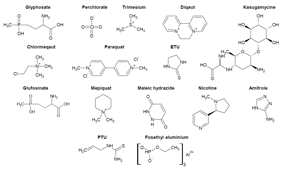Shimadzu has produced an application note describing highly polar pesticide multi-residue analysis in food safety by LC-MS/MS without the need for derivatisation.
 Introduction
Introduction
The analysis of highly polar pesticides by a single LC-MS/MS method is extremely challenging as a consequence of diverse separation and detection behaviour. Conventional approaches in highly polar pesticide analysis often use single residue methods or small group specific methods which are time consuming and limit throughput.
Aim of Study
The aim of this study was to develop a fast, sensitive and simple methodology for a range of challenging highly polar pesticides that require single-residue methods, by as few multiresidue LC-MS/MS runs as possible and without the need for derivatization. The panel of target analytes selected for analysis included glufosinate, glyphosate, ethephon, fosethyl aluminium, maleic hydrazide, perchlorate, ETU, PTU, nicotine, amitrole, chlormequat, daminozide, diquat, kasugamycine, mepiquat, paraquat and trimesium.
Method
Two LC-MS/MS methods were developed for the measurement of a range of highly polar pesticides in their underivitized state using the LCMS-8050 triple quadrupole mass spectrometer. All target compounds were quantified at 0.01 mg/kg which is below the European Union maximum residue limit for all studied compounds delivering a measurable impact on sample cycle time and productivity.
By downloading this application note you will:
- gain sufficient detail to reproduce the developed LC-MS/MS method.




